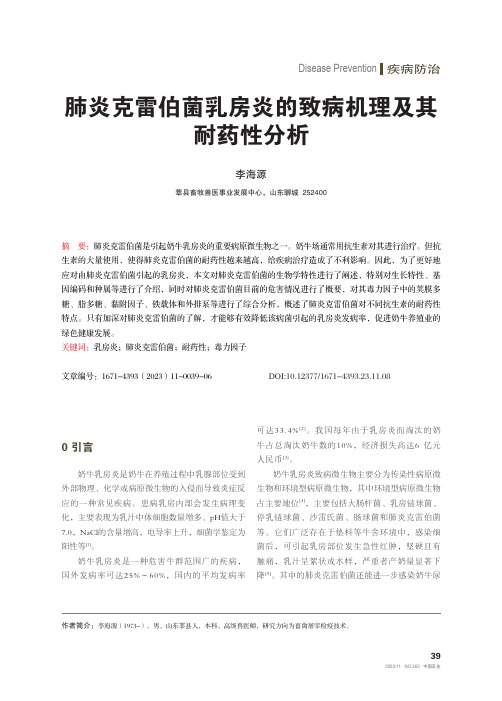肺炎克雷伯细菌及其荚膜
新生儿肺炎克雷伯菌脓毒症的护理

新生儿肺炎克雷伯菌脓毒症的护理一、新生儿肺炎克雷伯菌脓毒症概述1.肺炎克雷伯菌的生物学特性肺炎克雷伯菌是肠杆菌科克雷伯氏菌属中最为重要的一类细菌,革兰氏阴性杆菌,无芽孢,无鞭毛,有较厚的荚膜。
它在自然界广泛存在,如土壤、水、农产品等,同时也是人和动物肠道内的正常菌群之一。
然而,在特定条件下,如新生儿免疫力低下时,它可能会成为致病菌,引发严重的感染。
2.新生儿易感染的原因新生儿由于其免疫系统尚未完全发育成熟,皮肤和黏膜屏障功能较弱,容易受到病原体的侵袭。
此外,新生儿的肠道菌群尚未稳定建立,正常菌群的定植和抵抗病原体的能力相对不足。
再加上住院期间可能接触到各种医疗器械和医护人员的操作,增加了感染的风险。
3.肺炎克雷伯菌脓毒症的临床表现新生儿肺炎克雷伯菌脓毒症的临床表现可能不典型,常见的症状包括体温不稳定(发热或低体温)、呼吸急促或呼吸困难、心率增快、精神萎靡、食欲减退、黄疸加重等。
在严重情况下,可能会出现休克、多器官功能衰竭等危及生命的并发症。
二、新生儿肺炎克雷伯菌脓毒症的发病机制1.细菌侵入途径肺炎克雷伯菌可以通过多种途径侵入新生儿体内,如呼吸道吸入、皮肤破损处感染、胃肠道定植后移位、血行感染等。
其中,呼吸道和胃肠道是较为常见的侵入部位。
2.免疫反应失调新生儿的免疫系统在应对病原体感染时,可能会出现免疫反应失调的情况。
一方面,免疫细胞的数量和功能相对不足,导致对病原体的清除能力下降;另一方面,过度的炎症反应可能会导致组织损伤和器官功能障碍。
3.细菌毒素的作用肺炎克雷伯菌可以产生多种毒素,如内毒素、外毒素等。
这些毒素可以直接损伤细胞,破坏组织和器官的正常功能,从而加重病情。
三、新生儿肺炎克雷伯菌脓毒症的诊断方法1.临床症状和体征评估医生会仔细观察新生儿的体温、呼吸、心率、精神状态、皮肤颜色等症状和体征,结合病史进行初步判断。
2.实验室检查(1)血常规:白细胞计数升高或降低,中性粒细胞比例异常,血小板减少等。
克雷伯菌属优秀课件

20
初步鉴定 • 氧化酶(-) • 葡萄糖(+) • 动力(-) • 吲哚(-):产酸克雷伯(+) • 尿素酶(+)
21
基本生化
• TSI:⊕/⊕, • 枸(+) • 尿素酶(+), • 吲哚(-) • V-P(+) • 动力(-) • 鸟氨酸(-) • 丙二酸盐(+)
22
亚种鉴别
• 肺炎克雷伯菌三个亚种的鉴别关键是 IMViC试验;
所致疾病:肺炎、脑膜炎、腹膜炎、 泌尿系统感染、败血症
14
四、微生物学检验
(一)检验程序 (二)标本采集 (三)检验方法 (四)耐药性 (五)结果分析与报告
15
微生物检验
1、标本直接检验 2、分离培养与鉴定
16
标本的采集
• 肺部感染:采集痰液 • 肠炎采集粪便, • 败血症者采集血液, • 其他根据病症分别采集尿液、脓汁、脑
克雷伯菌属
一、分类 二、细菌特性 三、临床意义 四、微生物学检验
1
一、克雷伯菌属分类 肺炎克雷伯菌 臭鼻克雷伯菌 鼻硬结克雷伯菌 产酸克雷伯菌 解鸟氨酸克雷伯菌 植生克雷伯菌 土壤克雷伯菌
最常见:肺炎克雷伯菌
2
二、细菌特性
• 形态与染色
较短粗的杆菌,大小0.5~0.8×1~2um, 单独、成双或短链状排列。无芽胞,无 鞭毛,有较厚的荚膜,多数有菌毛。
12
• 抗原构造 具有O抗原与K抗原,后者用以分型。 利用荚膜肿胀试验,本属K抗原可分为82型。 肺炎克氏菌大多属3型和12型; 臭鼻克氏菌主要属4型,少数为5型或6型; 鼻硬结克氏菌一般属3型,但并非所有3型均为
该菌。
13
三、临床意义
克雷伯菌属的细菌多感染免疫力低 下的人群,是医院感染中最重要的条件 致病菌。
肺炎克雷伯杆菌肺炎

克雷白杆菌肺炎(Klebsiella pneumonia):近20余年来,该菌已成为院内获得性肺炎得主要致病菌,耐药株不断增加,且产生超广谱酶,成为防治中得难点、本病多见于中年以上男性,起病急、高热、咳嗽、痰多及胸痛,可有发绀、气急、心悸,约半数患者有畏寒,可早期出现休克。
临床表现类似因为得肺炎球菌肺炎,但其痰常呈粘稠脓性,量多、带血,灰绿色或砖红色、胶冻状,但此类典型得痰液并不多见。
胸部X线表现常呈多样性,包括大叶实变,好发于右肺上叶、双肺下叶,有多发性蜂窝状肺脓肿、叶间隙下坠、严重病例有呼吸衰竭、周围循环衰竭。
慢性病程者表现为咳嗽、咳痰、衰弱、贫血等、克雷白杆菌肺炎得预后较差,病死率高。
临床表现:①发病骤起,出现呼吸困难;②年长儿有大量黏稠血性痰,但婴儿少见;③由于气道被黏液梗阻,肺部体征较少或完全缺乏;④病情极为严重,发展迅速,患儿常呈休克状态;⑤X线胸片示肺段或大叶性致密实变阴影,其边缘往往膨胀凸出、可迅速发展到邻近肺段,以上叶后段及下叶前段较多见;⑥常见并发症为肺脓肿,可呈多房性蜂窝状,日后形成纤维性变;其次为脓胸及胸膜肥厚。
治疗尚缺乏有效抗菌药物。
临床病理:肺炎克雷白杆菌为革兰阴性杆菌,常存在于人体上呼吸道与肠道,当机体抵抗力降低时,便经呼吸道进入肺内而引起大叶或小叶融合性实变,以上叶较为多见。
病变中渗出液粘稠而重,致使叶间隙下坠、细菌具有荚膜,在肺泡内生长繁殖时,引起组织坏死、液化、形成单个或多发性脓肿。
病变累及胸膜、心包时,可引起渗出性或脓性积液。
病灶纤维组织增生活跃,易于机化;纤维素性胸腔积液可早期出现粘连。
在院内感染得败血症中,克雷白杆菌以及绿脓杆菌与沙雷菌等均为重要病原菌,病死率较高。
老年体弱患者有急性肺炎、中毒症状严重、且有血性粘稠痰者,应考虑本病。
确诊有赖于痰细菌学检查,并与葡萄球菌、结核菌或其她革兰阴性杆菌所致肺炎相鉴别。
年老、白细胞减少、菌血症及原有严重疾病者预后较差、与支气管扩张症区别支气管扩张症就是常见得慢性支气管化脓性疾病,大多数继发于呼吸道感染与支气管阻塞,尤其就是儿童与青年时期麻疹、百日咳后得支气管肺炎,由于破环支气管管壁,形成管腔扩张与变形。
肺炎克雷伯菌

肺炎克雷伯菌
肺炎克雷伯菌存在于人体上呼吸道和肠道,当机体抵抗力降低时,便经呼吸道进入肺内而引起大叶或小叶融合性实变,以上叶较为多见。
为革兰阴性杆菌,病变中渗出液粘稠而重,致使叶间隙下坠。
细菌具有荚膜,在肺泡内生长繁殖时,引起组织坏死、液化、形成单个或多发性脓肿。
病变累及胸膜、心包时,可引起渗出性或脓性积液。
病灶纤维组织增生活跃,易于机化;纤维素性胸腔积液可早期出现粘连。
在院内感染的败血症中,克雷白杆菌以及绿脓杆菌和沙雷菌等均为重要病原菌,病死率较高。
及早使用有效抗生素是治愈的关键。
首选氨基甙类抗生素,如庆大霉素、卡那霉素、妥布霉素、丁胺卡那霉素,可肌注、静滴或管腔内用药。
重症宜加用头孢菌素如头孢孟多、头孢西丁、头孢噻肟等。
哌拉西林,美洛西林与氨基甙类联用、以及氧氟沙星疗效亦佳。
部分病例使用氯霉素、四环素及SMZ-TMP亦有效。
重症多有肺组织损伤,慢性病例有时需行肺叶切除。
耐药机制:肺炎克雷伯菌(KNP)是临床分离及医院感染的重要致病菌之一,随着β-内酰胺类及氨基糖苷类等广谱抗菌素的广泛使用,细菌易产生超广谱β-内酰胺酶(ESBLs)和头孢菌素酶(AmpC酶)以及氨基糖苷类修饰酶(AMEs),对常用药物包括第三代头孢菌素和氨基糖苷类呈现出严重的多重耐药性。
肺炎克雷伯菌引起的医院感染率近期逐年增高,且多耐药性菌株的不断增加常导致临床抗菌药物治疗的失败和病程迁延。
肺炎克雷伯菌耐药机制主要包括产生β-内酰胺酶、生物被膜的形成、外膜孔蛋白的缺失。
抗菌药物主动外排等,抗菌药物耐药基因水平播散是多药耐药菌株临床加剧的重要原因。
微生物肺炎克雷伯

固定:手执玻片一端,有菌膜的一面朝上,通过微火三次(手指触摸反面不烫手为宜)疑菌落涂在干净的玻片上自然晾干,用结晶紫(1液)覆盖细菌初染1min,清水冲洗干净玻片再滴加革兰染液(2液)媒染1min,清水冲去表面的染液,用95﹪乙醇(3液)脱洗约30s(以乙醇不再有颜色为好),最后用稀释的复红(4液)复染30s。自然晾干后在显微镜下观察形态。
定科:氧化酶试验(-)、IMViC(- - ++) 定属:KIA(AA+ -)、MIU(- - +)、
O/F(F)、鸟氨酸脱羧酶试验(-)
01
02
I(吲哚):有些细菌具有色氨酸酶,能分解蛋白胨中的色氨酸产生吲哚,与对甲基氨基苯甲醛结合,生成红色化合物玫瑰吲哚。主要用于肠杆菌科细菌的鉴定。 M(甲基红):某些细菌分解葡萄糖产生丙酮酸,丙酮酸可进一步分解为甲酸、乙酸等酸性物质,不再继续分解,故培养基pH在4.5以下,加入甲基红指示剂后呈紫红色(阳性)。有些细菌将分解葡萄糖产生的酸进一步转化为醇酮等非酸性物质,使培养基pH在6.2以上,加入甲基红试剂成橘黄色(阴性)。一般用于肠杆菌科各菌属的鉴别。 Vi:某些细菌分解葡萄糖生成丙酮酸,丙酮酸可进一步脱羧生成乙酰甲基甲醇,乙酰甲基甲醇在碱性环境下被氧化成二乙酰,后者与蛋白胨中的精氨酸所含的胍基起作用,生成红色胍缩二乙酰,为VP试验阳性。若培养基中胍基含量少,加入少量含胍基的化合物如肌酸肌酐,可加速其反应。一般用于肠杆菌科各菌属的鉴别。 C(枸橼酸盐)枸橼酸盐培养基中不含任何糖类,枸橼酸盐为唯一碳源,磷酸二氢铵为唯一氮源。如果细菌能利用铵盐作为唯一氮源,并能利用枸橼酸盐作为唯一碳源,在枸橼酸盐培养基上生长,并分解枸橼酸盐为碳酸盐,使培养基变碱,指示剂溴麝香草酚蓝由绿色变为深蓝色,为枸橼酸盐利用实验阳性。若细菌不能利用枸橼酸盐为碳源,则细菌不能生长,培养基不变色。 back
肺炎克雷伯菌乳房炎的致病机理及其耐药性分析

肺炎克雷伯菌乳房炎的致病机理及其耐药性分析李海源莘县畜牧兽医事业发展中心,山东聊城 252400摘 要:肺炎克雷伯菌是引起奶牛乳房炎的重要病原微生物之一。
奶牛场通常用抗生素对其进行治疗。
但抗生素的大量使用,使得肺炎克雷伯菌的耐药性越来越高,给疾病治疗造成了不利影响。
因此,为了更好地应对由肺炎克雷伯菌引起的乳房炎,本文对肺炎克雷伯菌的生物学特性进行了阐述,特别对生长特性、基因编码和种属等进行了介绍,同时对肺炎克雷伯菌目前的危害情况进行了概要,对其毒力因子中的荚膜多糖、脂多糖、黏附因子、铁载体和外排泵等进行了综合分析,概述了肺炎克雷伯菌对不同抗生素的耐药性特点。
只有加深对肺炎克雷伯菌的了解,才能够有效降低该病菌引起的乳房炎发病率,促进奶牛养殖业的绿色健康发展。
关键词:乳房炎;肺炎克雷伯菌;耐药性;毒力因子文章编号:1671-4393(2023)11-0039-06 DOI:10.12377/1671-4393.23.11.080 引言奶牛乳房炎是奶牛在养殖过程中乳腺部位受到外部物理、化学或病原微生物的入侵而导致炎症反应的一种常见疾病。
患病乳房内部会发生病理变化,主要表现为乳汁中体细胞数量增多、pH值大于7.0,NaCl的含量增高,电导率上升,细菌学鉴定为阳性等[1]。
奶牛乳房炎是一种危害牛群范围广的疾病,国外发病率可达25%~60%,国内的平均发病率可达33.4%[2]。
我国每年由于乳房炎而淘汰的奶牛占总淘汰奶牛数的10%,经济损失高达6 亿元人民币[3]。
奶牛乳房炎致病微生物主要分为传染性病原微生物和环境型病原微生物,其中环境型病原微生物占主要地位[4],主要包括大肠杆菌、乳房链球菌、停乳链球菌、沙雷氏菌、肠球菌和肺炎克雷伯菌等。
它们广泛存在于垫料等牛舍环境中,感染细菌后,可引起乳房部位发生急性红肿,坚硬且有触痛,乳汁呈絮状或水样,严重者产奶量显著下降[5]。
其中的肺炎克雷伯菌还能进一步感染奶牛尿作者简介:李海源(1973-),男,山东莘县人,本科,高级兽医师,研究方向为畜禽屠宰检疫技术。
微生物肺炎克雷伯讲义
04
微生物肺炎克雷伯的诊断 与治疗
微生物肺炎克雷伯的诊断方法
临床表现
观察患者是否有咳嗽、咳痰、 呼吸困难等症状,以及是否有
发热、胸痛等体征。
实验室检查
通过血液检查、痰液检查等手 段,检测白细胞计数、C反应蛋 白等指标,以辅助诊断。
微生物肺炎克雷伯主要通过呼吸作用 进行代谢,利用氧气的氧化作用产生 能量。
微生物肺炎克雷伯的基因组与变异
微生物肺炎克雷伯的基因组较大,含有多个质粒和转座子, 容易发生变异。
微生物肺炎克雷伯的变异类型包括抗药性变异、毒力变异和 表型变异等,这些变异使得肺炎克雷伯具有更强的适应性和 生存能力。
03
微生物肺炎克雷伯的致病 性
对于呼吸困难的患者,给予吸氧、机械通 气等支持治疗措施,以改善呼吸功能。
并发症处理
预防复发
针对肺炎克雷伯菌感染可能引起的并发症 ,如心内膜炎、脑膜炎等,采取相应的治 疗措施。
对于高危人群或易感人群,采取预防措施 ,如加强免疫接种、改善生活方式等,以 降低复发风险。
微生物肺炎克雷伯的预防措施
加强卫生宣传
微生物肺炎克雷伯的感染机制
微生物肺炎克雷伯通过空气传播进入人体,首先在呼吸道定植,然后通过血液传播 至肺部,引起感染。
微生物肺炎克雷伯在人体内繁殖,破坏肺部组织,引发炎症反应,导致肺炎。
微生物肺炎克雷伯的感染机制还包括对呼吸道上皮细胞的粘附作用和对免疫系统的 逃避。
微生物肺炎克雷伯的毒力因子
微生物肺炎克雷伯产生多种毒力因子 ,如荚膜、外毒素和溶血素等,这些 毒力因子可导致肺部炎症、组织损伤 和免疫逃避。
肺炎克雷伯杆菌肺炎
克雷白杆菌肺炎(Klebsiella pneumonia):近20余年来,该菌已成为院内获得性肺炎得主要致病菌,耐药株不断增加,且产生超广谱酶,成为防治中得难点。
本病多见于中年以上男性,起病急、高热、咳嗽、痰多及胸痛,可有发绀、气急、心悸,约半数患者有畏寒,可早期出现休克。
临床表现类似因为得肺炎球菌肺炎,但其痰常呈粘稠脓性,量多、带血,灰绿色或砖红色、胶冻状,但此类典型得痰液并不多见、胸部X线表现常呈多样性,包括大叶实变,好发于右肺上叶、双肺下叶,有多发性蜂窝状肺脓肿、叶间隙下坠。
严重病例有呼吸衰竭、周围循环衰竭、慢性病程者表现为咳嗽、咳痰、衰弱、贫血等。
克雷白杆菌肺炎得预后较差,病死率高、临床表现:①发病骤起,出现呼吸困难;②年长儿有大量黏稠血性痰,但婴儿少见;③由于气道被黏液梗阻,肺部体征较少或完全缺乏;④病情极为严重,发展迅速,患儿常呈休克状态;⑤X线胸片示肺段或大叶性致密实变阴影,其边缘往往膨胀凸出、可迅速发展到邻近肺段,以上叶后段及下叶前段较多见;⑥常见并发症为肺脓肿,可呈多房性蜂窝状,日后形成纤维性变;其次为脓胸及胸膜肥厚、治疗尚缺乏有效抗菌药物。
临床病理:肺炎克雷白杆菌为革兰阴性杆菌,常存在于人体上呼吸道与肠道,当机体抵抗力降低时,便经呼吸道进入肺内而引起大叶或小叶融合性实变,以上叶较为多见。
病变中渗出液粘稠而重,致使叶间隙下坠。
细菌具有荚膜,在肺泡内生长繁殖时,引起组织坏死、液化、形成单个或多发性脓肿、病变累及胸膜、心包时,可引起渗出性或脓性积液。
病灶纤维组织增生活跃,易于机化;纤维素性胸腔积液可早期出现粘连、在院内感染得败血症中,克雷白杆菌以及绿脓杆菌与沙雷菌等均为重要病原菌,病死率较高、老年体弱患者有急性肺炎、中毒症状严重、且有血性粘稠痰者,应考虑本病。
确诊有赖于痰细菌学检查,并与葡萄球菌、结核菌或其她革兰阴性杆菌所致肺炎相鉴别。
年老、白细胞减少、菌血症及原有严重疾病者预后较差。
肺炎克雷伯菌的实验活动生物危害评估报告
肺炎克雷伯菌的实验活动生物危害评估报告一、细菌的传播与致病肺炎克雷伯菌广泛分布于自然界及人和动物的胃肠道内,是临床标本中常见的细菌,可引起典型的原发性肺炎,该菌在正常人鼻咽部的带菌率1%~6%,但在住院病人中可高达20%;该菌是酒精中毒者、糖尿病人和慢性阻塞性肺部疾病患者并发肺部感染的潜在危险因素;肺炎克雷伯菌也能引起各种肺外感染,包括肠炎和脑膜炎婴儿、泌尿道感染儿童和成人及败血症;近十几年来由该菌引起的免疫低下患者感染和医院感染不断增加,已成为社区感染和医院感染的重要病原菌;其对抗生素的耐药性也不断增强;二、细菌的生物学特性肺炎克雷伯菌属于肠杆菌科克雷伯菌属,为革兰氏阴性杆菌,无鞭毛、无芽胞,但有明显的荚膜;兼性厌氧,对营养的要求不高;三、细菌的实验室检查及其它检查1.标本采集采自不同感染部位的各种标本,主要是痰标本;2.分离培养将标本接种于血琼脂和或MAC选择性培养基,于37℃孵育过夜;可分别形成较大的、凸起、灰白色粘液型的菌落以及MAC上红色易扩散至周围的培养基中、大而厚实、粘液型光亮的菌落;这些相邻的菌落容易发生融合,用接种针沾取时常可挑出长丝状的细丝;3.染色镜检可见革兰氏阴性杆菌,无芽胞,但在菌体外有明显的荚膜;4.生化鉴定该菌氧化酶阴性,发酵葡萄糖产酸产气、动力阴性、吲哚阴性、鸟氨酸脱羧酶阴性、VP试验阳性、脲酶阳性;5.生长试验该菌不能在5℃和10℃生长,但能41℃生长;6.荚膜肿胀试验可利用特异性的抗血清进行荚膜肿胀试验以鉴别本菌属及类似菌属;将待测菌接种于华-弗Worfel-Ferguson培养基上有利于荚膜的产生,经35℃、18~24h培养后,取一滴培养物加于载玻片上,加墨汁一滴或美蓝液一滴,再加入抗血清1接种环,混合后加盖玻片,置显微镜油镜下观察;在菌体周围出现较大的空白圈者为阳性;该菌表现为阳性;7.肠毒素测定对小儿肠炎患者除了要做菌种鉴定外,尚需做肠毒素测定以明确被检菌的致病力;可用兔肠接扎试验、细胞形态变化等方法测定;四、细菌的防治目前几乎所有的肺炎克雷伯菌临床分离株都携带有耐氨卞青霉素和羧卞青霉素的R质粒,由于该菌对抗生素的耐药性一直不断增强,所以临床一定要结合药敏试验的结果进行针对性用药;该菌为条件致病菌,易感人群主要是免疫功能较低下者;因此应及时隔离治疗患者,并作好家庭、社区和医院的消毒;五、细菌的生物安全防护根据病原微生物生物实验室生物安全管理条例中的有关规定,人间传播的微生物名录待颁布肺炎克雷伯菌属于三类,BSL-2;1操作要求1、实验时,未经实验室主任同意,限制或禁止进入实验室;2、不许在工作区域饮食、吸烟、清洗隐型眼镜和化妆;食物应存放在工作区域以外专用橱柜或冰箱中;3、所有的操作过程应尽量细心,避免产生和溅出气溶胶;4、对于污染的锐器,必须时刻保持高度的警惕,包括针、注射器、玻片、加样器等;5、注射和吸取感染材料时,只能使用针头固定注射器或一次性注射器即注射器和针头是一体的;用过的一次性针头必须弯曲、切断、破碎、重新套上针头套、从一次性注射器上去掉,或在丢弃前进行人工处理,要不将之小心放入不会被刺穿的、用于收集废弃锐器的容器中;非一次性锐器必须放置在坚壁容器中,转移至处理区消毒,最好高压杀菌;6、打碎的器皿不能直接用手处理,必须用其它工具处理,如刷子和簸箕、夹子或镊子;盛污染的针头、锐器、碎玻璃的容器在倒掉前,应按照相关的规定进行消毒;7、所有的培养物、储存物及其它规定的废物在释放前,均应使用可行的消毒方法进行消毒,如高压灭菌;转移到就近实验室消毒的物料应置于耐用、防漏容器内,密封运出实验室;离开该系统进行消毒的物料,在转移前应包装,其包装应符合有关的法规;8、溅出或偶然事件中,明显暴露于传染源时,要立即向实验室主任报告;进行适当的医学评估、观察、治疗,保留书面记录;9、按日常程序、在有关传染源的工作结束后、尤其是传染源溅出或洒出后、或受到其他传染源污染后,实验室设备和工作台面应当使用有效的消毒剂消毒;污染的设备在送去修理、维护前,要按照相关的规定消毒;在离开设施转移前,要按照相关的规定打包运输;2安全设备1、正确使用和保养生物安全柜、最好是二级生物安全柜、或其他合适的人员防护设施、或物理遏制装置;2、确定可能形成传染性气溶胶或溅出物的实验过程,包括离心、研磨、匀浆、剧烈震荡或混匀、超声波破裂、开启装有传染源的容器、采集感染标本等;3、涉及高浓度或大体积的传染源时,若选用密封转头或带安全罩的离心机,若转头或安全罩仅在生物安全柜中打开,则可在开放实验室内离心;4、当必须在生物安全柜外处理标本时,需采取面部保护措施跟镜、口罩、面罩、或其他防溅装置,以免传染源或其他有害物溅或洒到面上;5、在实验室内,必须使用专用的防护性外衣、大褂、罩衫或制服;人员到非实验室区域时,防护服必须留在实验室内;防护服可以在实验室内处理,也可以在洗衣房中洗涤,但不能带回家中;6、可能接触潜在传染源、被污染的表面或设备时,要戴手套;一次性手套不用清洗、不能重复使用,不能用于接触“洁净”的表面键盘、电话等,也不应当戴着到实验室外;要备有带滑石粉的乳胶手套;脱掉手套后,要洗手;。
常见细菌及图片
肺炎克雷伯菌1.宇文皓月2.形态结构:肺炎克雷伯菌肺炎亚种为革兰阴性杆菌,无鞭毛,无芽孢,标本直接涂片或在营养丰富培养基上的营养物可见菌体外有明显的荚膜。
3.培养特性:兼性厌氧,营养要求不高,在初次分离培养基可形成较大、凸起灰白色黏液型的菌落。
菌落大而厚实、光亮,相邻菌落容易发生融合,用接种蘸取时可挑出长丝状细丝。
在麦康凯琼脂(MAC)培养基上形成较大的黏液型、红色的菌落,红色可扩散至菌落周围的培养基中。
在伊红美蓝琼脂(EMB)上为大、粘稠、红色、易融合成一片的菌落。
在血琼脂上为灰白色、大而黏、光亮且形成菌丝的菌落。
4.生化特性:氧化酶阴性,葡萄糖产酸产气,动力阴性,吲哚阴性,脲酶阳性。
金黄色葡萄球菌典型的金黄色葡萄球菌为球型,直径0.8μm左右,显微镜下排列成葡萄串状。
金黄色葡萄球菌无芽胞、鞭毛,大多数无荚膜,革兰氏染色阳性。
金黄色葡萄球菌营养要求不高,在普通培养基上生长良好,需氧或兼性厌氧,最适生长温度37°C,最适生长pH7.4。
平板上菌落厚、有光泽、圆形凸起,直径1-2mm。
血平板菌落周围形成透明的溶血环。
在EMB培养基上基本不生长。
金黄色葡萄球菌有高度的耐盐性,可在10-15%NaCl肉汤中生长。
可分解葡萄糖、麦芽糖、乳糖、蔗糖,产酸不产气。
甲基红反应阳性,VP反应弱阳性。
许多菌株可分解精氨酸,水解尿素,还原硝酸盐,液化明胶。
金黄色葡萄球菌具有较强的抵抗力,对磺胺类药物敏感性低,但对青霉素、红霉素等高度敏感。
大肠埃希氏菌1.形态与染色特性菌体两端钝圆、中等大小,杆状(有时呈卵圆形)、1—3um X0.6um、周生鞭毛,能运动,不发生荚膜,革兰氏阴性,而且一般是对碱性染料着色较好,但有时两端着色较浓,要与巴氏杆菌区分开来。
2.培养特性1)需氧及兼性厌氧菌2)对营养的要求不高,在普通琼脂上就生长良好,在15C-45℃范围内均可生长,但最适生长温度为37℃,最适pH为7.2—7.4。
- 1、下载文档前请自行甄别文档内容的完整性,平台不提供额外的编辑、内容补充、找答案等附加服务。
- 2、"仅部分预览"的文档,不可在线预览部分如存在完整性等问题,可反馈申请退款(可完整预览的文档不适用该条件!)。
- 3、如文档侵犯您的权益,请联系客服反馈,我们会尽快为您处理(人工客服工作时间:9:00-18:30)。
Klebsiella pneumoniae Bacteremia and Capsular Serotypes, Taiwan Chun-Hsing Liao, Yu-Tsung Huang, Chih-Cheng Lai, Cheng-Yu Chang, Fang-Yeh Chu, Meng-Shiuan Hsu, Hsin-Sui Hsu, and Po-Ren HsuehCapsular serotypes of 225 Klebsiella pneumoniae isolates in Taiwan were identi fi ed by using PCR. Patients infected with K1 serotypes (41 isolates) had increased community-onset bacteremia, more nonfatal diseases and liver abscesses, lower Pittsburgh bacteremia scores and mortality rates, and fewer urinary tract infections than patients infected with non–K1/K2 serotypes (147 isolates).Klebsiella pneumoniae bacteria cause a variety of infections (1,2). Geographic differences in this organism have been recognized, and a high prevalence of liver abscesses has been observed for >20 years in persons in Taiwan infected with K . pneumoniae (3,4). K1 and K2 are the major capsular serotypes that cause liver abscesses and have increased virulence (4–7). In contrast, only limited information is available about serotypes causing K. pneumoniae bacteremia (3,5).Yu et al. grouped K1 and K2 serotypes and compared clinical characteristics for patients with K. pneumoniae bacteremia with those for patients infected with non–K1/K2 serotypes (3). Recent evidence suggests that K1 is a major cause of primary liver abscesses and has greater potential for causing metastasis, and that K2 is a major cause of secondary liver abscesses (6,8). We examined the distribution and clinical characteristics of serotypes that cause K. pneumoniae bacteremia from 225 patients (9) and performed PCR-based genotyping to identify capsular serotypes (10).The StudyThe study was conducted at Far-Eastern Memorial Hospital in Taipei, Taiwan. Patients with K . pneumoniae bacteremia were identi fi ed during January 1–December31, 2007. Identi fi cation of K . pneumoniae was based oncolony morphologic features and biochemical reactions(11). Data on time until positive blood culture results wereobtained from the automated blood culture system at the hospital. Data for each patient were included only once (atthe time of the fi rst detection of bacteremia). Patients <18years of age and those not admitted to our hospital wereexcluded. Inactive malignancy was not included as anunderlying illness. In-hospital and 14-day mortality rateswere assessed. For 225 available bacterial isolates, cps genotyping was performed (10).A total of 231 patients with K . pneumoniae bacteremia were observed at the hospital during the study; 225 isolates from 225 patients were used. A total of 133 (59%) of these patients had community-onset bacteremia (bacteremia identi fi ed in an emergency department). The in-hospital mortality rate was 32.4%. Among 225 isolates, 41 (18.2%) were identi fi ed as K1 serotype, 37 (16.4%) as K2, 15 (6.7%) as K57, and 8 (3.6%) as K54. The K1 serotype was found predominantly in community-onset infections (36 [87.8%] of 41 patients compared with 75 [51.0%] of 147 patients infected with non–K1/K2 serotypes; odds ratio [OR] 6.91, 95% con fi dence interval [CI] 2.57–18.60) (online Appendix Table 1, /EID/content/17/6/1113-appT1.htm).Underlying illness was classi fi ed as nonfatal in 75.6% of patients with K1 bacteremia (53.7% of patients with non–K1/K2 bacteremia; OR 2.67, 95% CI 1.22–5.84). A lower percentage of patients with K1 bacteremia had surgery in the previous 3 months (9.8% vs. 30.6%; OR 0.25, 95% CI 0.09–0.73). Patients with K1 bacteremia had lower mean ± SD Pittsburgh bacteremia scores than those with non–K1/K2 bacteremia (2.7 ± 3.1 vs. 4.4 ± 4.7; OR 0.90, 95% CI 0.81–0.99), but the time until a positive blood culture was obtained was not different. K1 serotype was more common in patients with liver abscesses (46.3% vs. 4.1%; OR 20.3, 95% CI 7.31–56.40) and less common in patients with urinary tract infections (UTIs) (4.9% vs. 20.4%; OR 0.20, 95% CI 0.05–0.88). The in-hospital mortality rate for patients with K1 bacteremia was lower that that for patients with non–K1/K2 bacteremia (14.6% vs. 34.7%; OR 0.32, 95% CI 0.13–0.82).No differences were found in clinical characteristics for patients with K2 bacteremia and those with non–K1/K2 bacteremia except for a higher frequency of liver abscesses in patients with K2 bacteremia (13.5% vs. 4.1%; OR 3.67, 95% CI 1.06–12.8). For patients infected with K54 and K57 serotypes, 1 K57 serotype caused liver abscesses; no abscesses were found in patients infected with a K54 serotype. The in-hospital mortality rate was 50% (4/8) for patients with K54 bacteremia and 53.3% (8/15) for patients with K57 bacteremia.Patients infected with a K1 serotype had lower mean ± SD Pittsburgh bacteremia scores (2.7 ± 3.1 vs. 5.0 ± 5.3;Emerging Infectious Diseases • /eid • Vol. 17, No. 6, June 20111113Author af fi liations: Far Eastern Memorial Hospital, Taipei, Taiwan (C.-H. Liao, C.-C. Lai, C.-Y . Chang, F.-Y . Chu, M.-S. Hsu, H.-S. Hsu); and National Taiwan University College of Medicine, Taipei (Y .-T. Huang, P .-R. Hsueh)DOI: 10.3201/eid1706.100811OR 0.88, 95% CI 0.78–0.98, p = 0.002) and lower 14-day and in-hospital mortality rates (9.8% vs. 27.0%; OR 0.29, 95% CI 0.08–1.03, p = 0.06; and 14.6% vs. 43.2%; OR 0.23, 95% CI 0.08–0.67, p = 0.007) than patients infected with K2 serotypes. A higher percentage of patients with K1 bacteremia had liver abscesses at the site of infection (46.3% vs. 13.5%; OR 5.53, 95% CI 1.80–17.02, p = 0.003).Characteristics of patients with community-onset K. pneumoniae bacteremia were also analyzed (online Appendix Table 2, /EID/content/17/6/1113-appT2.htm). Patients infected with a K1 serotype were more likely to have liver abscesses and less likely to have UTIs or biliary tract infections (OR 11.5, 95% CI 3.99–33.20; OR 0.20, 95% CI 0.04–0.92; and OR 0.25, 95% CI 0.07–0.91, respectively).In our patients, K1 and K2 serotypes were found at similar frequencies (18.2% and 16.4%, respectively), which differs from results of Fung et al., in which the K1 serotype was more common (K1 30.8% and K2 5.1%) (12). Despite reported virulence of the K1 serotype, it was primarily responsible for community-onset bacteremia in patients with less severe underlying illness and associated with lower mortality rates. Moreover, the K1 serotype is associated with liver abscesses and lower mortality rates (2–7). Liver abscesses were found in 46% of patients with K1 bacteremia, and a K1 serotype was found in 63.3% of patients with liver abscesses.ConclusionsManagement of liver abscesses has improved in Taiwan because of increased physician awareness (13). Mortality rates for patients with K. pneumoniae bacteremia were lower in patients with UTIs or biliary tract infections (5,14), which were less common in patients infected with a K1 serotype. Thus, patient outcomes depend more on underlying conditions and severity of sepsis than on bacterial serotypes (5,9,14).In our previous study of the interval until a positive blood culture for K. pneumoniae bacteremia was obtained(9), we found that higher Pittsburgh bacteremia scores,a time until a positive blood culture <7 hours, and active malignancy were associated with death. In this study, we found no difference in time until a positive blood culture was obtained for patients infected with different serotypes. This interval for patients infected with K1 serotypes was slightly longer than that for patients infected with K2 and non–K1/K2 serotypes. This finding may have resulted from a higher percentage of community-onset infections and liver abscesses and less severe underlying illness in patients infected with a K1 serotype.Studies investigating K. pneumoniae bacteremia have grouped K1 and K2 serotypes (3,7). However, such grouping may be problematic because evidence suggests that the K1 serotype is the major cause of primary liver abscesses (6). Another report showed that the genetic background of serotype K2 is diversifi ed, and only 1 of the 2 major K2 clones was highly virulent in mice (15). These findings are consistent with our clinical observations. Differences in symptoms of patients infected with K2 and non–K1/K2 serotypes were minimal, despite slightly more liver abscesses among patients infected with K2 serotypes, which was lower than for patients infected with K1 serotypes. Because of different serotyping methods used (3,5,15), caution is required when interpreting data from various studies.Despite greater virulence of the K1 serotype, it is predominant in patients with community-onset infections and in those with less severe underlying illness. Although the K1 serotype is the major cause of liver abscesses, it results in a lower mortality rate, which can be attributed to host factors.Dr Liao is an infectious diseases specialist in the Department of Internal Medicine, Far-Eastern Memorial Hospital, Taipei, Taiwan. His research interests are clinical characteristics, epidemiology, and pathogenesis of bacterial infections, particularly methicillin-resistant Staphylococcus aureus and Klebsiella pneumoniae.References1. García de la Torre M, Romero-Vivas J, Martínez-Beltrán J, Guer-rero A, Meseguer M, Bouza E. Klebsiella bacteremia: an analy-sis of 100 episodes. Rev Infect Dis. 1985;7:143–50. doi:10.1093/clinids/7.2.1432. Ko WC, Paterson DL, Sagnimeni AJ, Hansen DS, V on Gottberg A,Mohapatra S, et al. Community-acquired Klebsiella pneumoniaebacteremia: global differences in clinical patterns. Emerg Infect Dis.2002;8:160–6. doi:10.3201/eid0802.0100253. Yu VL, Hansen DS, Ko WC, Sagnimeni A, Klugman KP, von Gott-berg A, et al. Virulence characteristics of Klebsiella and clinical manifestations of K. pneumoniae bloodstream infections. Emerg Infect Dis. 2007;13:986–93.4. Wang JH, Liu YC, Lee SS, Yen MY, Chen YS, Wang JH, et al. Pri-mary liver abscess due to Klebsiella pneumoniae in Taiwan. ClinInfect Dis. 1998;26:1434–8. doi:10.1086/5163695. Tsay RW, Siu LK, Fung CP, Chang FY. Characteristics of bactere-mia between community-acquired and nosocomial Klebsiella pneu-moniae infection: risk factor for mortality and the impact of capsularserotypes as a herald for community-acquired infection. Arch InternMed. 2002;162:1021–7. doi:10.1001/archinte.162.9.10216. Fang CT, Lai SY, Yi WC, Hsueh PR, Liu KL, Chang SC. Klebsiellapneumoniae genotype K1: an emerging pathogen that causes septicocular or central nervous system complications from pyogenic liverabscess. Clin Infect Dis. 2007;45:284–93. doi:10.1086/5192627. Yu WL, Ko WC, Cheng KC, Lee CC, Lai CC, Chuang YC. Compari-son of prevalence of virulence factors for Klebsiella pneumoniae liv-er abscesses between isolates with capsular K1/K2 and non-K1/K2serotypes. Diagn Microbiol Infect Dis. 2008;62:1–6. doi:10.1016/j.diagmicrobio.2008.04.007DISPATCHES1114 Emerging Infectious Diseases • /eid • Vol. 17, No. 6, June 2011K . pneumoniae Bacteremia and Capsular Serotypes8. Brisse S, Fevre C, Passet V , Issenhuth-Jeanjean S, Tournebize R,Diancourt L, et al. Virulent clones of Klebsiella pneumoniae : identi-fi cation and evolutionary scenario based on genomic and phenotypic characterization. PLoS ONE. 2009;4:e4982. doi:10.1371/journal.pone.00049829. Liao CH, Lai CC, Hsu MS, Huang YT, Chu FY , Hsu HS, et al. Cor-relation between time to positivity of blood cultures with clinical presentation and outcomes in patients with Klebsiella pneumoniae bacteraemia: prospective cohort study. Clin Microbiol Infect. 2009;15:1119–25. doi:10.1111/j.1469-0691.2009.02720.x10. Pan YJ, Fang HC, Yang HC, Lin TL, Hsieh PF, Tsai FC, et al. Cap-sular polysaccharide synthesis regions in Klebsiella pneumoniae serotype K57 and a new capsular serotype. J Clin Microbiol. 2008;46:2231–40. doi:10.1128/JCM.01716-0711. Abbott SL. Klebsiella, Enterobacter, Citrobacter, Serratia, Plesi-omonas , and other Enterobacteriaceae . In: Murray PR, Baron EJ, Pfaller MA, Tenover FC, Yolken RH, editors. Manual of clinical microbiology, 8th ed. Washington: American Society for Microbiol-ogy; 2003. p. 684–700.12. Fung CP, Hu BS, Chang FY , Lee SC, Kuo BI, Ho M, et al. A 5-yearstudy of the seroepidemiology of Klebsiella pneumoniae : high prev-alence of capsular serotype K1 in Taiwan and implication for vac-cine ef fi cacy. J Infect Dis. 2000;181:2075–9. doi:10.1086/31548813. Tsai FC, Huang YT, Chang LY , Wang JT. Pyogenic liver abscessas endemic disease, Taiwan. Emerg Infect Dis. 2008;14:1592–600. doi:10.3201/eid1410.07125414. Meatherall BL, Gregson D, Ross T, Pitout JD, Laupland KB. In-cidence, risk factors, and outcomes of Klebsiella pneumoni-ae bacteremia. Am J Med. 2009;122:866–73. doi:10.1016/j.amjmed.2009.03.03415. Brisse S, Issenhuth-Jeanjean S, Grimont PA. Molecular serotyp-ing of Klebsiella species isolates by restriction of the ampli fi edcapsular antigen gene cluster. J Clin Microbiol. 2004;42:3388–98. doi:10.1128/JCM.42.8.3388-3398.2004Address for correspondence: Po-Ren Hsueh, Departments of Laboratory Medicine and Internal Medicine, National Taiwan University Hospital, No. 7, Chung-Shan South Rd, Taipei, Taiwan; email: hsporen@.twEmerging Infectious Diseases • /eid • Vol. 17, No. 6, June 20111115。
